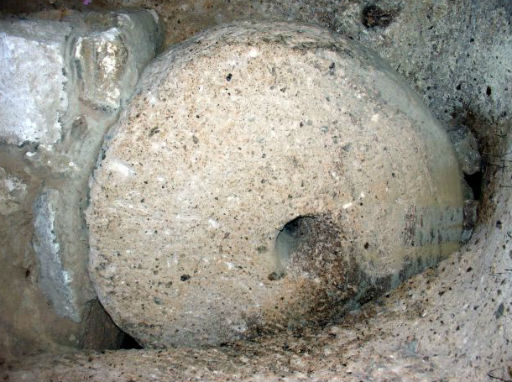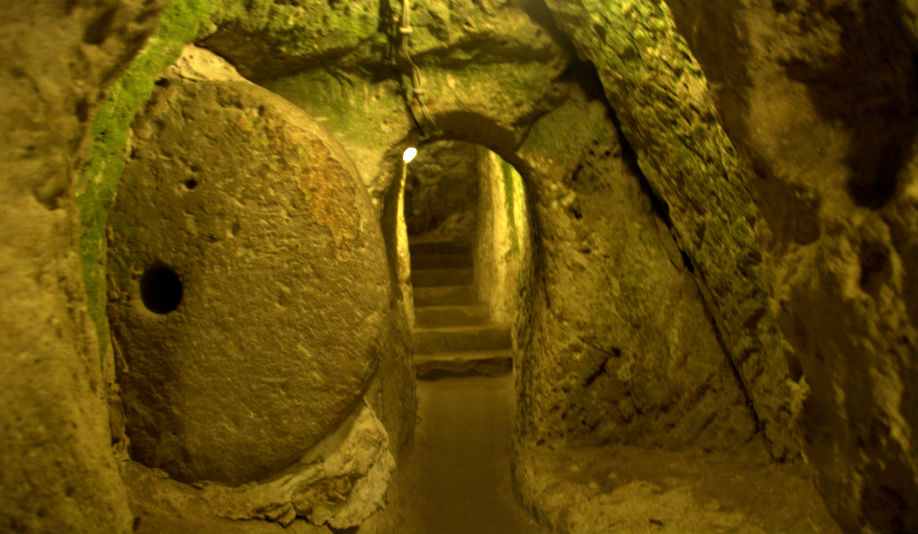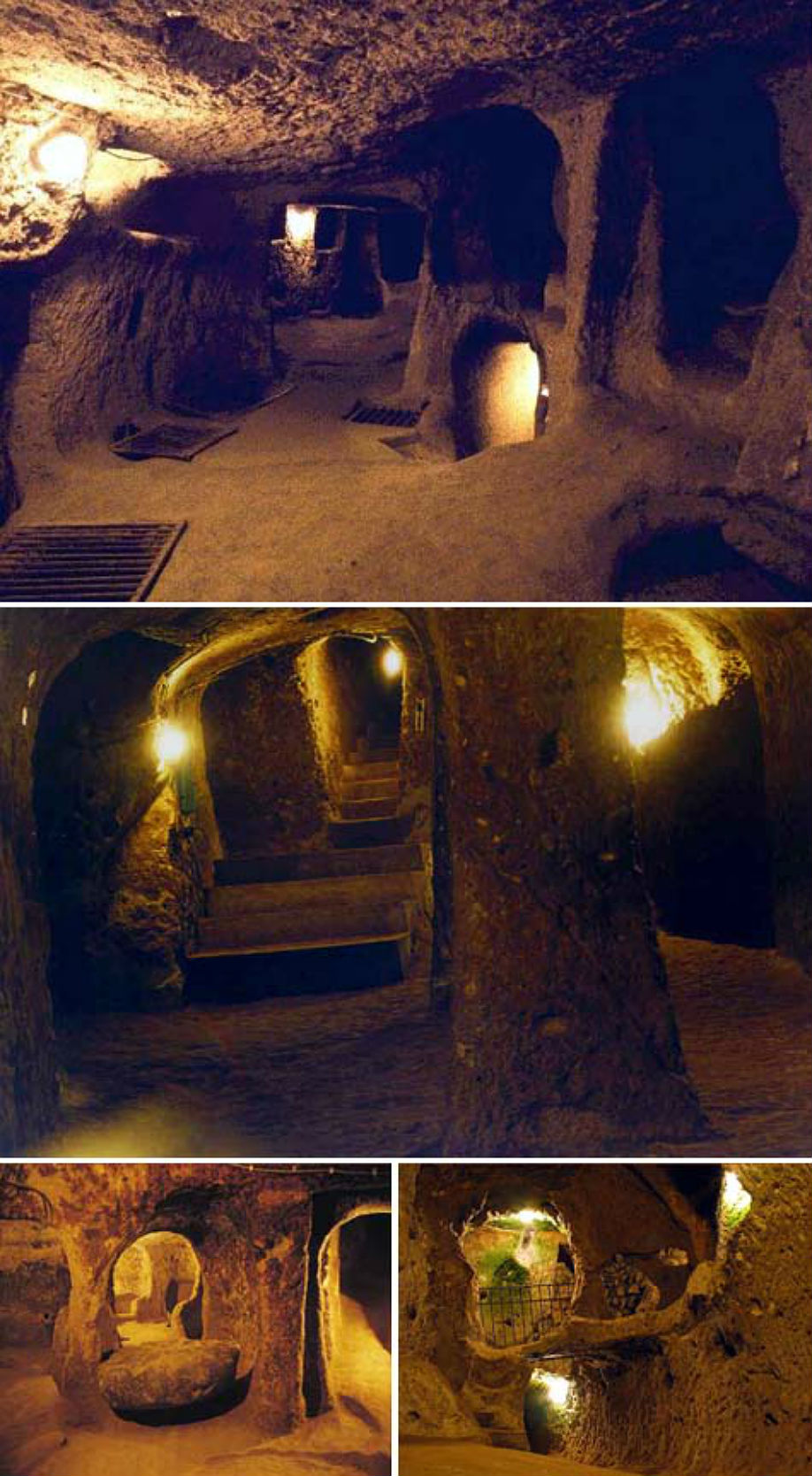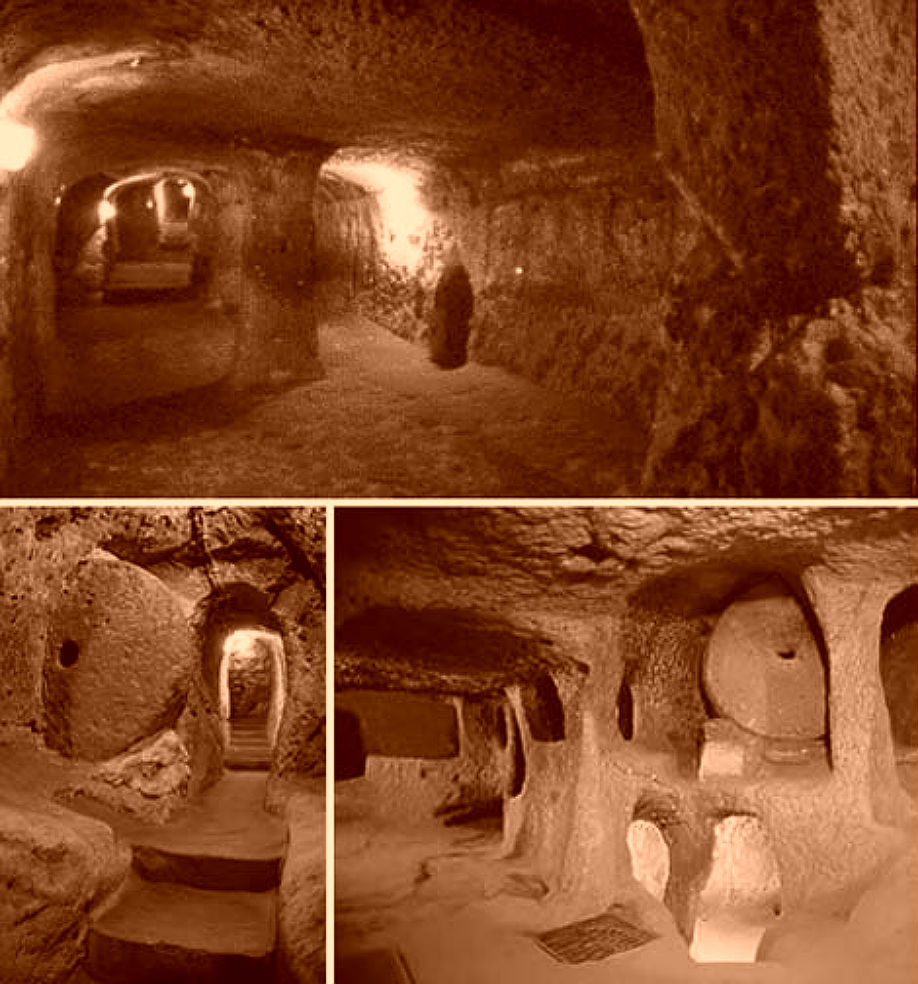Derinkuyu Underground City is an ancient multi-level underground city of the Median Empire in the Derinkuyu district in Nevşehir Province, Turkey.
Extending to a depth of approximately 60 m, it was large enough to shelter approximately 20,000 people together with their livestock and food stores.
It is the largest excavated underground city in Turkey and is one of several underground complexes found across Cappadocia.

One of the heavy stone doors. They have a height of 1–1,5 m, 30–50 cm in width and weigh 200–500 kg. The hole in the centre can be used to open or close the millstone, or to see who is outside.
It was opened to visitors in 1969 and to date, about half of the underground city is accessible to tourists. The underground city at Derinkuyu could be closed from the inside with large stone doors. Each floor could be closed off separately.
The city could accommodate up to 20,000 people and had all the usual amenities found in other underground complexes across Cappadocia, such as wine and oil presses, stables, cellars, storage rooms, refectories, and chapels. Unique to the Derinkuyu complex and located on the second floor is a spacious room with a barrel vaulted ceiling. It has been reported that this room was used as a religious school and the rooms to the left were studies.
Between the third and fourth levels is a vertical staircase. This passage way leads to a cruciform church on the lowest (fifth) level.
The large 55 m ventilation shaft appears to have been used as a well. The shaft also provided water to both the villagers above and, if the outside world was not accessible, to those in hiding.
History
First built in the soft volcanic rock of the Cappadocia region, possibly by the Phrygians in the 8th–7th centuries B.C according to the Turkish Department of Culture, the underground city at Derinkuyu may have been enlarged in the Byzantine era. During the Persian Achaemenid empire the city was used as a refugee settlement. There are references to underground refugee settlements built by the Persian king Yima in the second chapter of the Zoroastrian book Vendidad. Therefore many scholars believe that the city may have been built by the Persians. The city was connected with other underground cities through miles of tunnels.
Some artifacts discovered in these underground settlements belong to the Middle Byzantine Period, between the 5th and the 10th centuries A.D. It is speculated that the number of underground settlements, generally used for taking refuge and for religious purposes, increased during this era.
Derinkuyu Underground City, Cappadocia,





Deinkuyu is the deepest underground city and is also quieter than the other ones. We had a guide (60 Lira for 4 people) and it really made a big difference, as we could really put into context why the city was dug the way it was, its functions etc. I think it's a must see if you're in the region.
On my bus trip through Turkey two days were scheduled for Cappadocia sightseeing. What an experience and what a wonderful unexpected fairy tale land -By day we visited the underground dwellings, caves, churches in the rocks and took very early morning balloon rides. A visit to a typical Turkish cave house was included- I could have just stayed there. Stopping…
One of the more unusual places on earth……. the scene of more than a few films.
Natural rock formations with a difference.
Amazing, kind and friendly staff. Really cool hotel- never been a cave hotel before! A unique experience. Fast wireless. Beautiful view. In the city center, close to great restaurants and reasonably priced and local products shopping.
Lovely experience! Very romantic and different! Perfect for a couple! Although you have to make a careful choice! the furniture were also traditional but the other amenities were modern!!!
the tour of this underground city was amazing though a little difficult to maneuver inside. The city could accommodate up to 20,000 people and had all the usual amenities such as wine and oil presses, stables, cellars, storage rooms, refectories, and chapels. its a must see site for anyone visiting this part of turkey.
Spent the day very active and enjoyed the underground city.
Derinkuyu was amazing. It's an 8th or 7th century B.C.E. multi-level underground city which seemingly just keeps going forever. I believe our tour guide told us only about 10% of it was open to visitors, but there's a lot to be seen in that 10%. Several passages and stairways, kitchens, rooms, meeting rooms, live-stock storage areas, etc.
Its a UNESCO World Heritage Sight and worth to visit.Claustrophobic persons may have unpleasant experience.Obese people and very tall people have problems as tunnels are quite narrow n long to travel.
I couldn't believe that this cave can enter 5,000 people. but I have look around there, I thought capacity was enough to enter 5,000 people. I think, this cave was well-made in view of engineering, because of water supply, air supply, trap, etc. Because of narrow path, sometimes it was difficult to pass in the cave.